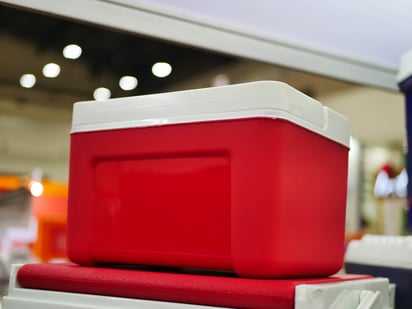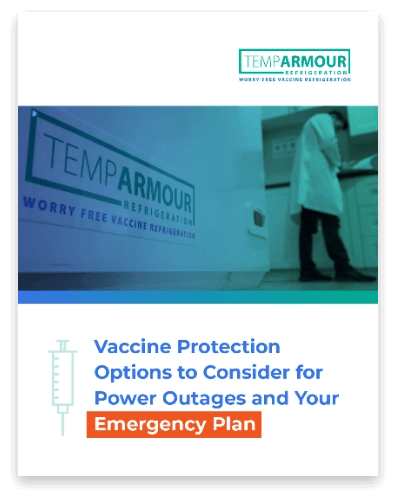
There are many reasons that vaccines are transported, whether it is to bring vaccines to a satellite site, to run an off-site immunization clinic, or to move vaccines prior to a storm or other event that triggered the site's vaccine emergency management plan.
A common and inexpensive method for packing and transporting vaccines is using a standard cooler with ice packs. However, this method is relatively time consuming, requiring close attention to packing to ensure that vaccines are properly protected from freezing. Transporting vaccines with a standard cooler and ice packs is also not always recommended for every situation.
How Packing Vaccines for Transport Has Changed
Modern technology means that there are now options besides using standard ice packs. And if you’re used to carrying vaccines around from site to site, the latest vaccine coolers are poised to make your life much easier.
Many nurses are just becoming aware that portable PCM Vaccine Carriers made specifically for vaccine transport are easier to pack, provide more fail-safe protection for vaccines, and maintain vaccines for up to 3 days in temperature range.
Rather than having to carefully pack your vaccines in a cooler in such a way that none are in direct contact with the ice packs, you can simplify the process by choosing a more advanced vaccine cooler.
How to Pick a Cooler for Vaccine Transport
Simply put, traditional food and beverage coolers were not designed to transport temperature-sensitive materials such as vaccines that need to stay within a narrow temperature range.
Traditional coolers are simply designed to keep cold air from escaping a confined space. This works fine if you want to keep your lunch relatively cold, but they are not ideal if you need to transport vaccines without spoiling them. PCM carriers built purposely for vaccine transport address the unique challenges of moving vaccines.
A cooler specifically designed to keep the cold chain intact such as a TempArmour Vaccine Carrier is an easier alternative for nurses to pack and transport vaccines. The TempArmour Vaccine Carrier is a qualified container and pack out that uses PCM and VIP Technology to protect vaccines from freezing and keep them in temperature range for 3 days.
How To Pack Vaccines for Transport
As you may already know, packing vaccines in coolers with ice packs requires special precautions.
There are some variations in instructions, however the main principle is to ensure that the refrigerated vaccines are not in direct contact with the ice packs and there is enough of a barrier between the two so that vaccines have no chance of developing any crystals of ice as even the slightest bit of freezing of refrigerated vaccines can render them unusable.
The CDC Vaccine Storage and Handling Toolkit links to the Packing Vaccines for Transport during Emergencies Tool which is a widely used set of instructions on how to safely transport vaccines in a standard hard sided or styrofoam cooler with ice packs (or frozen water bottles). Of course, follow your Clinic or Organization’s instructions if provided.
Ensure that all the supplies are ready and the ice packs are frozen and properly conditioned before you get started!
Alternatively, you can choose a carrier that is purpose-built for vaccines, easier to pack, protects refrigerated vaccines from freezing, and maintains vaccines in the required temperature range for up to 3 days.
Advantages of the TempArmour Purpose-built Vaccine Transport Carrier:
- Incorporates Phase Change Materials
Phase change materials (PCM) are formulated to keep temperatures stable in a specified temperature range by absorbing or releasing latent energy.
Consider using a PCM Vaccine Carrier to transport your vaccines. A PCM Vaccine Carrier is an alternative that streamlines cooler and pack preparation, which ultimately saves time and reduces potential for user error in packing. The Phase Change Material in PCM vaccine carriers keeps the vaccines in the correct temperature range. Vaccines can be safely placed anywhere within the carrier, even directly next to the PCM packs.
Modern PCM vaccine coolers don’t just eliminate the need for ice packs. They eliminate the cold spots or dangers of freezing that come with ice packs, which is why PCM is a must-have feature if you’re picking out a vaccine cooler. - The TempArmour Carrier is a Qualified Container and Packout:
A Qualified Container and Packout is a cooler that has been lab tested to determine how many hours it will stay within a specified temperature range under a particular set of circumstances.
For vaccine protection, it is very useful to have a good understanding of the time frame that you can expect from a vaccine carrier, whether it is being used for a short period of time to move vaccines to satellite sites, or for an entire day at Immunization Clinics. - Incorporates Vacuum Insulated Panel Technology (VIP)
The Centers for Disease Control (CDC) stresses the importance of never using soft-sided food or beverage coolers for vaccine transportation because they’re often “poorly insulated.”
Instead, look for coolers with vacuum insulated panels. Vacuum insulated panels (VIPs) are a type of insulation that is often several times more effective than other options.
There are some things to remember no matter what you are using to move your vaccines:
- Use an Accurate Temperature Monitoring Device
As you’re moving vaccines, you should always be able to monitor the temperature within your cooler, and the CDC recommends using a digital data logger (DDL). This way you can see if there are any temperature changes within the cooler without disturbing the vaccines.
At the same time, your temperature monitor needs to be accurate. It should be calibrated to have an accuracy of +/-0 .5 degrees Celsius, or +/-1 degree Fahrenheit. - Transport your vaccine carrier or vaccine cooler in the car with you, not in the trunk of the vehicle.
Other Considerations when choosing a Vaccine Carrier
Make Sure It’s Easy to Move
Anyone who’s working as an off-site nurse and moving vaccines from one place to another knows how important a mobile cooler is. Traditional coolers can be heavy and awkward to move.
Consider choosing coolers that are light and have transport-friendly designs with features such as pockets for accessories and rolling carts.
If one person will be transporting the vaccines, consider using 2+ smaller coolers with a manageable weight (e.g. 20 lbs) versus a larger cooler that can often weigh 60-100+ lbs.
Choose a Carrier that is specifically for Vaccines
Choosing a Vaccine Carrier specifically designed for vaccines ensures that User Manuals, instructions, and labels are clear and specific to vaccine transport protocols.
Keep Simplicity in Mind
Let's face it: nurses, doctors and other practitioners charged with maintaining the safety of vaccines are busy so alternatives that simplify and save time while improving vaccine protection are worthwhile to consider.
Our vaccine storage and transport specialists would be happy to assist you with any questions that you may have.
Want to stay up to date on vaccine transport and the latest best practices? We want to help you stay informed. Subscribe to our blog here.


